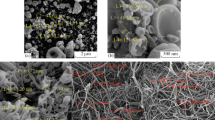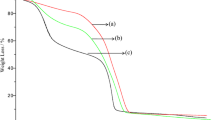Abstract
Propranolol (PPL) imprinted microspheres (MIP) were successfully prepared via oil/water polymerization using a methyl methacrylate (MMA) monomer, PLL template, and divinylbenzene (DVB) cross-linker and favorably incorporated in a Eudragit-RS100 nanofiber membrane. A non-PPL imprinted polymer (NIP), without a template, was used as a control. The morphology and particle size of the beads were investigated using scanning electron microscopy. The results revealed that both MIP and NIP had a spherical shape with a micron size of approximately 50–100 μm depending on the amounts of DVB and PPL used. NIP2 (MMA/DVB, 75:2.5) and MIP8 (PPL/MMA/DVB, 0.8:75:2.5) were selected for reloading of PPL, and the result indicated that increasing the ratio of PPL to polymer beads resulted in increase PPL reloading (>80%). A total of 10–50% NIP2 or MIP8 was incorporated into a 40% (w/v) Eudragit-RS100 fiber membrane using an electrospinning technique. PPL could be bound to the 50% MIP8 composite fiber membrane with a higher extent and at a higher rate than the control (NIP2). Furthermore, the MIP8 composite fiber membrane showed higher selectivity to PPL than the other β-blockers (atenolol, metoprolol, and timolol). Thus, the MIP8 composite fiber membrane can be further developed for various applications in pharmaceutical and other affinity separation fields.








Similar content being viewed by others

References
Ma Z, Kotaki M, Ramakrishna S. Surface modified nonwoven polysulphone (PSU) fiber mesh by electrospinning: a novel affinity membrane. J Membr Sci. 2006;272(1–2):179–87.
Ma Z, Kotaki M, Ramakrishna S. Electrospun cellulose nanofiber as affinity membrane. J Membr Sci. 2005;265(1–2):115–23.
Borcherding H, Hicke H, Jorcke D, Ulbricht M. Surface functionalized microfiltration membranes for affinity separation. Desalination. 2002;149(1–3):297–302.
Mosbach K, Ramstrom O. The emerging technique of molecular imprinting and its future impact on biotechnology. Nat Biotechnol. 1996;14:163–70.
Ye L, Haupt K. Molecularly imprinted polymers as antibody and receptor mimics for assays, sensors and drug discovery. Anal Bioanal Chem. 2004;378:1887–97.
Ye L, Weiss R, Mosbach K. Synthesis and characterization of molecularly imprinted microspheres. Macromolecules. 2000;33:8239–45.
Vlatakis G, Andersson LI, Miller R, Mosbach K. Drug assay using antibody mimics made by molecular imprinting. Nature. 1993;361:645–7.
Yan H, Row KH. Characteristic and synthetic approach of molecularly imprinted polymer. Int J Mol Sci. 2006;7:155–78.
Lubke C, Lubke M, Whitcombe MJ, Vulfson EN. Imprinted polymers prepared with stoichiometric template–monomer complexes: efficient binding of ampicillin from aqueous solutions. Macromolecules. 2000;33:5098–105.
Yao LD, Tang YW, Huang ZF. Nicotinic acid voltammetric sensor based on molecularly imprinted polymer membrane-modified electrode. Anal Lett. 2007;40:677–88.
Haupt K, Mosbach K. Molecularly imprinted polymers and their use in biomimetic sensors. Chem Rev. 2000;100:2495–504.
Kriz O, Ramstrom O, Mosbach K. Molecular imprinting: new possibilities for sensor technology. Anal Chem. 1997;69:345A–9.
Ansell RJ, Kriz D, Mosbach K. Molecularly imprinted polymers for bioanalysis: chromatography, binding assays and biomimetic sensors. Curr Opin Biotechnol. 1996;7:89–94.
Liu HY, Row KH, Yan GL. Monolithic molecularly imprinted columns for chromatographic separation. Chromatographia. 2005;61:429–32.
Hwang CC, Lee WC. Chromatographic resolution of the enantiomers of phenylpropanolamine by using molecularly imprinted polymer as the stationary phase. J Chromatogr B. 2001;765:45–53.
Martin PD, Jones GR, Stringer F, Wilson ID. Comparison of normal and reversed-phase solid phase extraction methods for extraction of β-blockers from plasma using molecularly imprinted polymers. Analyst. 2003;128:345–50.
Lavignac N, Allender CJ, Brain KR. Current status of molecularly imprinted polymers as alternatives to antibodies in sorbent assays. Anal Chim Acta. 2004;510:139–45.
Ye L, Mosbach K. Molecularly imprinted microspheres as antibody binding mimics. React Funct Polym. 2001;48:149–57.
Chianella I, Lotierzo M, Piletsky SA, Tothill IE, Chen B, Karim K, et al. Rational design of a polymer specific for microcystin-LR using a computational approach. Anal Chem. 2002;74:1288–93.
Son SH, Jegal J. Chiral separation of D, L-serine racemate using a molecularly imprinted polymer composite membrane. J Appl Polym Sci. 2007;104:1866–72.
Zaidi SA, Cheong WJ. Robust open tubular layer of S-ketoprofen imprinted polymer for chiral LC separation. J Sep Sci. 2008;31:2962–70.
Yoshimatsu K, Ye L, Lindberg J, Chronakis IS. Selective molecular adsorption using electrospun nanofiber affinity membranes. Biosens Bioelectron. 2008;23:1208–15.
Bhardwaj N, Kundu SC. Electrospinning: a fascinating fiber fabrication technique. Biotechnol Adv. 2010;28:325–47.
Bamford CH, Al-Lamee KG, Pm-brick MD, Wear TJ. Studies of a novel membrane for affinity separations. I. Functionalisation and protein coupling. J Chromatogr. 1992;606:19–31.
Ongun MZ, Ertekin K, Gocmenturk M, Ergun Y, Suslu A. Copper ion sensing with fluorescent electrospun nanofibers. Spectrochim Acta A Mol Biomol Spectrosc. 2012;90:177–85.
Charernsriwilaiwat N, Opanasopit P, Rojanarata T, Ngawhirunpat T. Lysozyme-loaded, electrospun chitosan-based nanofiber mats for wound healing. Int J Pharm. 2012;427:379–84.
Yoshimatsu K, Reimhult K, Krozer A, Mosbach K, Sode K, Ye L. Uniform molecularly imprinted microspheres and nanoparticles prepared by precipitation polymerization: the control of particle size suitable for different analytical applications. Anal Chim Acta. 2007;584:112–21.
Acknowledgments
The authors would like to acknowledge Commission of Higher Education (Thailand) and the Thailand Research Funds through the Golden Jubilee Ph.D. Program (grant no. PHD/0092/2554) and the Silpakorn University Research and development institute for the financial support (grant no. SURID55/02/12).
Author information
Authors and Affiliations
Corresponding author
Rights and permissions
About this article
Cite this article
Tonglairoum, P., Chaijaroenluk, W., Rojanarata, T. et al. Development and Characterization of Propranolol Selective Molecular Imprinted Polymer Composite Electrospun Nanofiber Membrane. AAPS PharmSciTech 14, 838–846 (2013). https://doi.org/10.1208/s12249-013-9970-0
Received:
Accepted:
Published:
Issue Date:
DOI: https://doi.org/10.1208/s12249-013-9970-0



